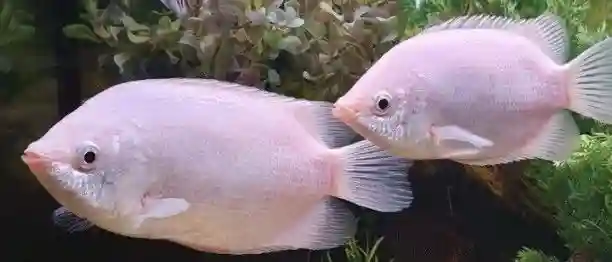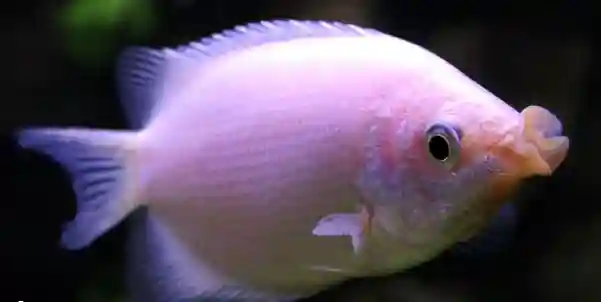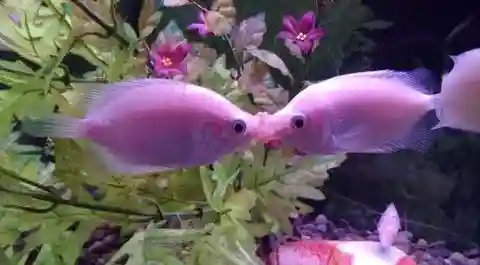The Kissing Gourami, known scientifically as “Helostoma temminckii,” is a beautiful freshwater fish that has captured the hearts of aquarium enthusiasts around the world. It also known as Green kisser (Pink kisser). With their distinctive appearance and intriguing behavior, these fish have become a popular choice for both beginners and experienced hobbyists. In this comprehensive guide, we’ll explore the world of Kissing Gouramis, covering their characteristics, habitat, care requirements, and much more.
Characteristics of Fish Kissing Gourami
Kissing Gouramis are native to Southeast Asia, particularly Thailand, Malaysia, and Indonesia. These fish belong to the family Osphronemidae, which includes other popular aquarium species like the Betta fish.

Kissing gouramis are famous for their unique mouths with super-strong, fleshy lips. These lips can stretch out to give things like rocks, plants, food, and even each other a little “kiss.”
Now, here’s an interesting twist: they don’t have teeth on their palate or jaws. Instead, they’ve got lots of tiny, rust-colored mucous membrane teeth coated with enamel.
Kissing gouramis usually grow to about 20 centimeters (7.87 in) long. But hey, some of them can even stretch up to a maximum length of 30 centimeters (12 in)! Quite the size difference they can pull off!
Kissing Gouramis have a striking appearance with several key characteristics that make them stand out in any aquarium:
| Characteristic | Description |
|---|---|
| Appearance | Varied colors (pink, silver, blue) |
| Size | Average size: 8–12 inches |
| Mouth | Uniquely shaped for ‘kissing’ illusion, important for social interaction |
| Labyrinth Organ | Allows breathing atmospheric air, survival in low-oxygen water |
| Varieties | Silver, Blue, Albino, Gold, Opaline, each with distinct coloration |

Tips: Males and females don’t show significant physical contrasts. The best way to tell them apart is by watching the female as she grows plumper with eggs during the spawning season.
Lifespan of Kissing Gaurami (Pink kisser)
Kissing gouramis usually live about 5 to 7 years when kept in tanks.
Now, even though you can’t predict exactly how long your fish will live, you can help them stay healthy for as long as possible. Keeping their home super clean is key. These fish love a stable environment, so make sure their water quality stays top-notch. They get unhappy with changes in water conditions or if there’s too much ammonia in the tank. So, keeping the water fresh and the conditions steady will keep them in great shape.
Habitat and Tank Setup
Creating the ideal environment for your Kissing-Gourami is crucial for their well-being and happiness. To mimic their natural habitat, consider the following factors when setting up their aquarium:
- Tank Size: Due to their potential size, a minimum of a 50-gallon tank is recommended. This size provides ample space for them to swim and interact.
- Aquarium Decor: Include plenty of plants (both real and artificial) and hiding spots, such as caves and driftwood. Kissing-Gouramis enjoy having places to explore and feel secure.
- Water Conditions: Maintain a temperature range of 75 to 82 degrees Fahrenheit (24 to 28 degrees Celsius) and a slightly acidic to neutral pH level (6.0 to 7.0).
- Filtration: A good filtration system is essential to keep the water clean and maintain a healthy environment for your fish.
Feeding Your Kissing Gourami
A balanced diet is vital for the health of your Kissing Goura. These fish are omnivores, meaning they consume both plant matter and small aquatic creatures. Providing a variety of foods is essential to ensuring they receive proper nutrition.
- Pellets and Flakes: High-quality pellets and flakes formulated for tropical fish are a great staple food. Look for options that contain a mix of protein and plant-based ingredients.
- Live and Frozen Foods: Treat your Kissing-Gourami are live or frozen foods like brine shrimp, bloodworms, and daphnia. These foods mimic their natural diet and provide essential nutrients.
Kissing Gourami Behavior

Observing the behavior of Kissing Gouramis can be truly fascinating. These fish are known for their social interactions, which include their unique “kissing” behavior. Here are some interesting behavioral traits to watch for:
- Kissing: Kissing Gouramis exhibit kissing behavior as a form of communication. This behavior is more commonly seen during courtship and territorial displays.
- Schooling: Kissing-Gouramis are generally peaceful fish, but they enjoy the company of their kind. Keeping them in small groups (known as schools) can reduce stress and promote natural behavior.
- Exploration: These fish are curious by nature and will explore their environment. You’ll often see them investigating plants, decorations, and other elements in the tank.
Varieties of Kissing Gouramis
- Pink Kissing Gourami: This variety is one of the most popular and easily recognizable. The Pink Kisser boasts a beautiful pale pink hue that adds a touch of elegance to any tank. Its peaceful demeanor and unique mouth shape make it a delightful addition to community aquariums.
- Gold Kissing Gourami: The Gold Kissing Gourami dazzles with its bright, golden-yellow color. It’s a beautiful fish that stands out in aquariums, especially when contrasted with lush green plants or darker substrates.
- Silver Kissing Gourami: The Silver Kissing-Gourami is a quieter yet gorgeous type. Its grayish-silver color brings a calm vibe, making it perfect for folks who want a peaceful aquarium setup.
- Blue Kissing Gourami: The Blue Kissing Gourami is a hard-to-find and highly desired type. Its stunning blue color really stands out in the tank, making it a top pick for fans who love vibrant colors.
- Albino Kissing Gourami: Albino fish always capture the attention of hobbyists, and the Albino Kissing Gourami is no exception. Its lack of pigmentation gives it a translucent appearance, making it a unique and captivating addition to any aquarium.
- Opaline Gourami: While not a true “Kissing” Gourami, the Opaline Gourami is closely related to and often confused with the Kissing variety. The Opaline Gourami is known for its iridescent opal-like colors, which shimmer in shades of blue, green, and pink under the right lighting.
Choosing the Right Variety
Selecting the perfect Kissing-Gourami variety for your aquarium depends on your preferences and the overall aesthetic you want to achieve. Consider the following factors:
- Tank Theme: The color and mood you want to create in your tank can influence your choice. Bright and bold colors may stand out in a vibrant community, while subtler tones can create a peaceful atmosphere.
- Tank Mates: Consider the compatibility of the Kissing-Gourami variety with other fish species in your tank. Ensure that the chosen variety gets along well with the fish you already have or plan to introduce.
- Personal Preference: Ultimately, your personal preference matters. Choose a Kissing Gourami variety that resonates with you and adds joy to your aquarium hobby.
Caring for Kissing Gouramis
Regardless of the variety, kissing goura requires similar care:
- Aquarium Size: Ensure you have a tank that provides enough space for your Kissing Gouramis to swim comfortably. A 50-gallon tank or larger is recommended, especially if you plan to keep them with other fish.
- Water Quality: Maintain stable water parameters, including temperature (75–82 degrees Fahrenheit), pH (6.0–7.0), and proper filtration, to keep your Kissing-Gouramis healthy.
- Diet: Offer a varied diet that includes high-quality pellets, flakes, and occasional live or frozen foods like brine shrimp and bloodworms.
Common Health Issues and Care Tips
While Kissing Gouramis are relatively hardy, it’s essential to be aware of potential health issues and how to keep them in optimal condition.
- Ich (White Spot Disease): This common freshwater fish disease can affect Kissing Gouramis. Monitor your fish for signs of white spots on their fins and bodies, and treat the tank if an outbreak occurs.
- Water Quality: Regular water changes and maintaining proper water parameters are essential. Test the water regularly for ammonia, nitrite, and nitrate levels.
- Diet Variation: Providing a diverse diet is important. Avoid overfeeding, as it can lead to water quality issues. Feed them small amounts multiple times a day.
Kissing Gouramis Tank Mates
When selecting tank mates, it’s essential to choose fish with similar temperaments and requirements. Here are some fish species that are often compatible with Kissing Gouramis:
- Tetras: Species like Neon Tetras, Cardinal Tetras, and Glowlight Tetras can coexist peacefully with Kissing Gouramis. They add vibrant colors and lively activity to the tank.
- Guppies: Guppies are small, colorful, and non-aggressive fish that can thrive alongside Kissing Gouramis. They come in a wide variety of colors and tail shapes.
- Corydoras Catfish: These bottom-dwellers are peaceful and excellent at keeping the tank clean. Choose species like Bronze Corydoras or Panda Corydoras.
- Platies: Platies are hardy and easy to care for. They come in various colors and are a great addition to a community tank.
- Rasboras: Harlequin Rasboras and Espei Rasboras are peaceful shoaling fish that create a stunning visual display in the aquarium.
- Swordtails: Swordtails are beautiful and peaceful fish that add a touch of elegance to the tank. Ensure there are more females than males to prevent aggression.
Factors to Consider
While these fish are generally compatible with Kissing Gouramis, it’s essential to consider the following factors:
- Tank Size: A larger tank provides more space for fish to establish territories and reduces the likelihood of aggression. Aim for a tank of at least 50 gallons for a harmonious community.
- Water Parameters: Ensure that the water parameters, including temperature and pH, are suitable for all the fish species in the tank.
- Territorial Behavior: Some fish may exhibit territorial behavior, especially during breeding. Monitor the tank closely, and provide sufficient hiding spots and plants to create separate territories.
Avoiding Aggressive Tank Mates
While Kissing Gouramis are peaceful, it’s crucial to avoid aggressive or territorial fish that may stress or harm them. Fish like larger Cichlids, aggressive barbs, and fin-nipping species should be avoided to maintain a peaceful environment.
Conclusion
Taking care of kissing gouramis mostly revolves around handling their lively personalities. Once you get the hang of that, keeping these fish won’t be too tough. And trust me, it’s absolutely rewarding. They’re one-of-a-kind and a blast to have around. Their vibrant colors and lively behavior will make you happy that you welcomed them into your aquarium!
Frequently Asked Questions (FAQs)
-
Can Kissing Gouramis be kept with other fish in the same aquarium?
Yes, Kissing Gouramis are generally peaceful and can coexist with other peaceful community fish. However, monitor their behavior and ensure the tank size is suitable to prevent overcrowding.
-
How often should I feed my Kissing Gourami?
Feed your Kissing Gourami in small amounts 2-3 times a day. Ensure they consume the food within a few minutes to prevent overfeeding.
-
Do Kissing Gouramis require a heater in their aquarium?
Yes, Kissing Gouramis are tropical fish and require a heater to maintain a stable temperature within the recommended range.
-
Can Kissing Gouramis jump out of the tank?
Yes, they can jump if startled or stressed. Ensure your tank has a secure lid to prevent any accidental escapes.
-
Are Kissing Gouramis suitable for beginners?
Yes, Kissing Gouramis can be a good choice for beginners as long as you provide proper care and maintain a suitable environment.
-
How can I encourage breeding in Kissing Gouramis?
To encourage breeding, provide hiding spots and maintain water quality. Condition the fish with high-quality foods and slightly warmer water to simulate the rainy season, which can trigger breeding behavior.
Disclaimer
“As an Amazon Associate, we earn from qualifying purchases where there is no additional cost to you. This is one way to support us.” The products displayed here are well-researched, highly rated by users, and fast-moving.








